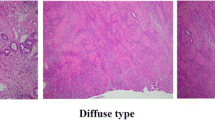Abstract
The aim of this prospective study was to analyze Ming’s classification in correlation with other currently used classification systems of gastric cancer. In addition, we wanted to define the prognostic significance of the Ming classification system. The present study analyzed material of 117 patients with gastric carcinoma who underwent D2-gastrectomy with curative intent. All specimens were catagorized according to International Union Against Cancer (UICC) classification, World Health Organization (WHO) classification, Borrmann classification, Laurén classification, Goseki classification, Ming classification, and tumor differentiation. For analysis of correlation between the classification systems, the correlation coefficient according to Spearman was calculated. The survival curves have been calculated according to the Kaplan-Meier method. According to the Ming classification, 38.5% of the carcinomas exhibited an expanding growth pattern, and 61.5% of specimens showed an infiltrating growth pattern. The subtypes according to the Ming and Laurén classification correlated significantly (P < 0.001). WHO classification (P < 0.001), tumor differentiation (P < 0.001), and Goseki classification (P < 0.001), as well as the macroscopic classification of Borrmann (P < 0.001) and the pT and pN categories of the UICC classification exhibited a highly significant correlation with the Ming classification (P < 0.001 and 0.001, respectively). Median overall survival was 31.3 months. In Kaplan-Meier analysis, the 3-year survival rates were lower in the infiltrative tumor type when compared to the expansive tumor type according to Ming (P = 0.0847). In multivariate analysis, only the UICC system presented as an independent prognostic factor in multivariate analysis (P < 0.001). This study shows that the Ming classification correlates significantly with the currently used classification systems for gastric cancer and with the UICC staging system, especially, the pT and pN category. The 3-year survival rates were lower in the infiltrative tumor type than in the expansive tumor type according to Ming. However, the Ming classification is not an independent prognostic factor.

Similar content being viewed by others
References
Ming SC. Gastric carcinoma: a pathobiological classification. Cancer 1977;39:2475–2485
Fenoglio-Preiser CM, Noffsinger AE, Belli J, et al. Pathologic and phenotypic features of gastric cancer. Semin Oncol 1996;23:292–306
Flucke U, Monig SP, Baldus SE, et al. Differences between biopsy- or specimen-related Lauren and World Health Organization classification in gastric cancer. World J Surg 2002;26:137–140
Lauren PA, Nevalainen TJ. Epidemiology of intestinal and diffuse types of gastric carcinoma. A time-trend study in Finland with comparison between studies from high- and low-risk areas Cancer 1993;71:2926–2933
Watanabe A, Oshiro T, Oiwa H, et al. Prognosis of patients with gastric cancer and pyloric stenosis: histological differentiation. Semin Surg Oncol 1994;10:121–124
Watanabe H, Nishimaki T. Factors affecting the growth and extension of gastric cancer—analysis of retrospective observation. Gan To Kagaku Ryoho 1983;10:482–488
Goseki N, Takizawa T, Koike M. Differences in the mode of the extension of gastric cancer classified by histological type: new histological classification of gastric carcinoma. Gut 1992;33:606–612
Monig S, Baldus SE, Collet PH, et al. Histological grading in gastric cancer by Goseki classification: correlation with histopathological subtypes and prognosis. Anticancer Res 2001;21:617–620
You WC, Blot WJ, Chang YS, et al. Diet and high risk of stomach cancer in Shandong, China. Cancer Res 1988;48:3518–3523
Brinton LA, Gridley G, Hrubec Z, et al. Cancer risk following pernicious anaemia. Br J Cancer 1989;59:810–813
Mullaney PJ, Wadley MS, Hyde C, et al. Appraisal of compliance with the UICC/AJCC staging system in the staging of gastric cancer. Union International Contra la Cancrum/American Joint Committee on Cancer. Br J Surg 2002;89:1405–1408
Bollschweiler E. Benefits and limitations of Kaplan-Meier calculations of survival chance in cancer surgery. Langenbecks Arch Surg 2003;388:239–244
Ming SC. Cellular and molecular pathology of gastric carcinoma and precursor lesions: a critical review. Gastric Cancer 1998;1:31–50
Jass JR, Sobin LH, Watanabe H. The World Health Organization’s histologic classification of gastrointestinal tumors. A commentary on the second edition, Cancer 1990;66:2162–2167
Mulligan RM. Histogenesis and biologic behavior of gastric carcinoma. Pathol Annu 1972;7:349–415
Filipe MI, Jankowski J. Growth factors and oncogenes in Barrett’s oesophagus and gastric metaplasia. Endoscopy 1993;25:637–641
Hermanek P. Tumors of the gastrointestinal tract and the pancreas: histopathology, staging and prognosis Anticancer Res 1999;19:2393–2396
Songun I, van de Velde CJ, Arends JW, et al. Classification of gastric carcinoma using the Goseki system provides prognostic information additional to TNM staging. Cancer 1999;85:2114–2118
Monig SP, Zirbes TK, Schroder W, et al. Staging of gastric cancer: correlation of lymph node size and metastatic infiltration. A.J.R. Am J Roentgenol 1999;173:365–367
Dixon MF, Martin IG, Sue-Ling HM, et al. Goseki grading in gastric cancer: comparison with existing systems of grading and its reproducibility. Histopathology 1994;25:309–316
Piard F, Hillon P, Levillain P, et al. Does Ming’s classification of gastric carcinomas have epidemiologic or prognostic value? Ann Pathol 1986;6:329–334
Davessar K, Pezzullo JC, Kessimian N, et al. Gastric adenocarcinoma: prognostic significance of several pathologic parameters and histologic classifications. Hum Pathol 1990;21:325–332
Ribeiro MM, Sarmento JA, Sobrinho Simoes MA, et al. Prognostic significance of Lauren and Ming classifications and other pathologic parameters in gastric carcinoma. Cancer 1981;47:780–784
Garnier P, Vielh P, Asselain B, et al. Prognostic value of the Lauren and Ming classifications in gastric adenocarcinoma. Multidimensional analysis. Gastroenterol. Clin Biol 1988;12:553–558
Cimerman M, Repse S, Jelenc F, et al. Comparison of Lauren’s, Ming’s and WHO histological classifications of gastric cancer as a prognostic factor for operated patients. Int Surg 1994;79:27–32
Dirschmid K, Scheiden R, Zimmermann G, et al. Tubular differentiated stomach carcinoma of the (Ming) infiltrating type. Pathologe 1996;17:122–126
Author information
Authors and Affiliations
Corresponding author
Rights and permissions
About this article
Cite this article
Luebke, T., Baldus, S.E., Grass, G. et al. Histological Grading in Gastric Cancer by Ming Classification: Correlation with Histopathological Subtypes, Metastasis, and Prognosis. World J. Surg. 29, 1422–1427 (2005). https://doi.org/10.1007/s00268-005-7795-z
Published:
Issue Date:
DOI: https://doi.org/10.1007/s00268-005-7795-z




